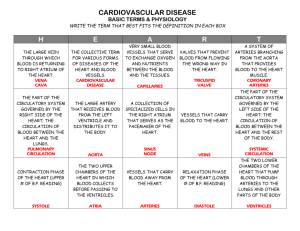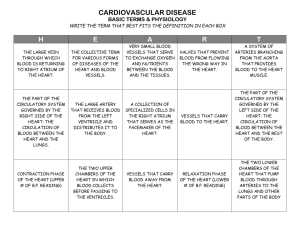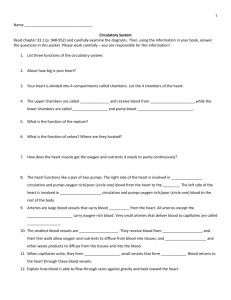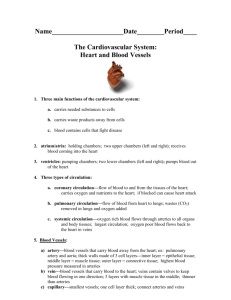Vascular Network = Blood Vessels
advertisement
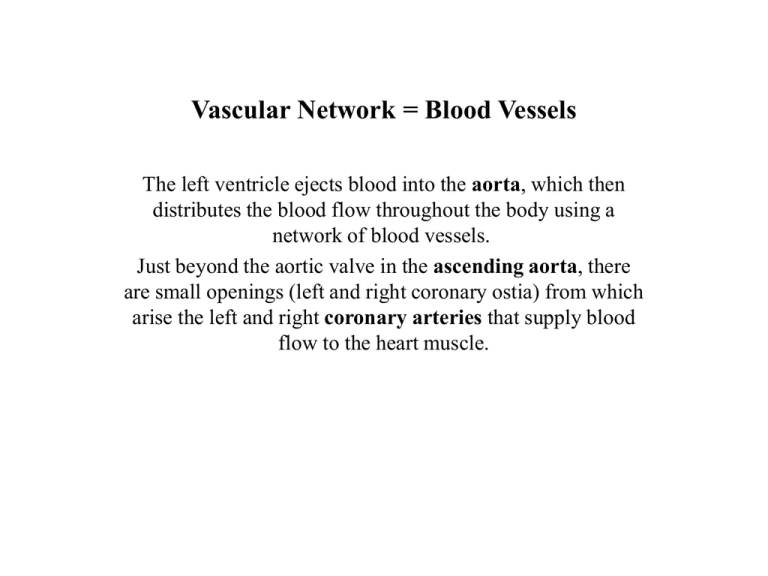
Vascular Network = Blood Vessels The left ventricle ejects blood into the aorta, which then distributes the blood flow throughout the body using a network of blood vessels. Just beyond the aortic valve in the ascending aorta, there are small openings (left and right coronary ostia) from which arise the left and right coronary arteries that supply blood flow to the heart muscle. Branches off the Aortic Arch • Near the top of the aortic arch, there are three major arteries that distribute blood flow to the upper thorax, arms and head. • The first is the brachiocephalic artery, which shortly branches into the right subclavian artery (supplies the upper thorax, right arm and head) and right common carotid artery (supplies head). • The next branch from the aortic arch is the left common carotid artery, which also supplies the head. • The third major artery arising from the aortic arch is the left subclavian artery, which supplies blood flow to the upper thorax, left arm and head. Descending Aorta • Past the arch, the aorta descends downward (descending aorta) through the thorax (thoracic aorta) where it gives off several small arterial vessels to supply blood flow to the thorax. • When the aorta passes through the diaphragm, it continues as the abdominal aorta. • Several major arteries branch from the abdominal aorta, including those that supply blood to the visceral organs (e.g., stomach, intestines, kidneys). • In the lower abdomen, the aorta bifurcates into the left and right common iliac arteries, which supply blood to the pelvic region and the legs via additional bifurcations and branches. Distribution of Blood Pressures and Volumes Qu ic kTim e ™ a nd a TIFF (Unco m press ed ) de com p re ss or are ne ed ed to see th is p ic tu re . • As shown in the figure to the left, the aorta and arteries have the highest pressure • In the small arteries and arterioles there is a large fall in mean blood pressure • When blood reaches the capillaries the mean pressure may be 25-30 mmHg, depending upon the organ • Pressure within the thoracic vena cava near the right atrium is very close to zero Blood Volume • Regarding the distribution of blood volume within the circulation, the greatest volume resides in the venous vessels, where 70-80% of the blood volume is found. • For this reason, veins are referred to as capacitance vessels. • The relative volume of blood between the arterial and venous sides of the circulation can vary considerably depending upon total blood volume, intravascular pressures, and vascular compliance. Blood Vessels • • • The aorta and large arteries branching off the aorta (e.g., carotid, mesenteric, renal arteries) distribute the blood flow to specific organs Once the distributing artery reaches the organ to which it supplies blood, it branches into smaller arteries that distribute blood flow within the organ These vessels continue to branch and become arterioles • Together, the small arteries and arterioles represent the primary vessels that are involved in the regulation of arterial blood pressure as well as blood flow within the organ Blood Vessels • • • • As arterioles become smaller in diameter, they lose their smooth muscle. Vessels that have no smooth muscle, but are composed of endothelial cells and a basement membrane, are termed capillaries, and represent the smallest vessels within the microcirculation. Capillaries are the primary exchange vessels within the body Across the capillary endothelium, oxygen, carbon dioxide, water, electrolytes, proteins, metabolic substrates and by-products (e.g., glucose, amino acids, lactic acid), and circulating hormones are exchanged between the plasma and the tissue interstitium surrounding the capillary. Blood Vessels • • • When capillaries join together, they form postcapillary venules, which also serve as exchange vessels, particularly for large macromolecules as well as fluid. As postcapillary venules join together and form larger venules, smooth muscle once again appears. These venous vessels, like the resistance vessels, are capable of dilating and constricting, and serve an important function in regulating capillary pressure. QuickTime™ and a TIFF (Uncompressed) decompressor are needed to see this picture. Blood Vessels • • • Venules form larger veins that serve as the primary capacitance vessels of the body - i.e., the site where most of the blood volume is found and where regional blood volume is regulated. For example, constriction of the veins decreases venous volume and increases venous pressure, which alters cardiac output. The final venous vessels are the inferior and superior vena cava, which carry the blood back to the right atrium of the heart. Blood Vessels VESS ELTYPE DIAM ETER(mm) Aorta 25 FUNC TION Puls e dam pening and distrib ution Larg e Ar teries 1.0- 4.0 Dist ribu tionofarterial blood Sm all Ar teries 0.2- 1.0 Dist ribu tionandresistance Arteri oles 0.01- 0.20 Resistance (pressur e &flowregu lation) Capillaries 0.006 - 0.010 Exchange Venul es 0.01- 0.20 Exchang e, co llection, and capacitan ce Veins 0.2- 5.0 Capacitancefun ction(blood volume) Vena Cava 35 Collectionofvenou s blood

